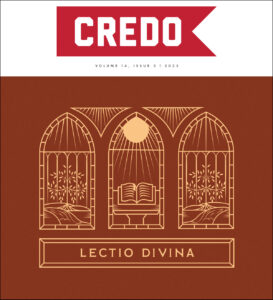
The Intersection Between Our Lives and Biblical History
N ow and again, some people ask me to mount an “apology” for, and explanation of, what many call “figural reading” of Scripture – an approach I have written about and been identified with. My main point, in response, is that I don’t really have to mount a defense, because figural reading is unavoidable for the Christian, whatever she or he may think, or even think they are doing.
ow and again, some people ask me to mount an “apology” for, and explanation of, what many call “figural reading” of Scripture – an approach I have written about and been identified with. My main point, in response, is that I don’t really have to mount a defense, because figural reading is unavoidable for the Christian, whatever she or he may think, or even think they are doing.
Maybe you are not familiar with the term, but it has been tossed about a bit more frequently in the past two decades within theological and biblical studies. It derives more or less, from a long-standing tradition in Christian interpretation of the Bible, now and then subject to debate, and since the 19th century mostly, met with disdain and opprobrium from most Protestant; since the mid-20th century. Catholic biblical scholars have offered their own critiques. Whether figural interpretation is having a revival is debatable. In a culture and church where anything and everything is for sale, as it were, everything has been revived. But that doesn’t constitute a living retrieval.
But before I move to my point – that figural interpretation is unavoidable for the Christian – let me offer a few starting definitions so we are on the same page.
Does a Figural Reading Pervade the Scriptures?
Figural reading is unavoidable for the Christian Click To Tweet Figural reading is often contrasted with a modern approach called the “historical-grammatical” method. According to this method, Scripture verbally refers to specific time-bound and discrete entities (whether real or imagined), and the language of Scripture more broadly serves to identify and place these entities (that’s what grammar serves to do). Take Judges 16:30[KJV] “And Samson said, Let me die with the Philistines. And he bowed himself with [all his] might; and the house fell upon the lords, and upon all the people that [were] therein. So, the dead which he slew at his death were more than [they] which he slew in his life.” A historical-grammatical reading of this text would insist that the words refer to a man named Samson, who lived in a such a such a year, and he was chained to a column in a building in such and such a place, dedicated to a god by the name of Dagon, worshipped by a people called the Philistines and on a certain day he pulled at his chains and dragged down the column and the temple and this and that person, including Samson, died at that time, and it all came about in this way.
Figural reading, by contrast, sees a scriptural text as referring to a range of entities, time bound or not, and often at once; and Scripture’s language serves to open up ourselves to this multivalent reality.
Consider a few examples:
- Exodus: in the Easter Vigil service we are told that the Exodus reading is for us a “sign of the salvation of all nations by the water of Baptism.”
- Samson in Judges 16:30: A figural reading would say that verse and its words refer first to those, including David, who follow God “in faith” (Heb. 11:32) in the train of the great “pioneer of faith,” Jesus on the Cross: let me die with the sinners, and let the demons of sin die with me.
- 1 Peter on the ark and baptism (3:20-21): baptism is an “antitype” of the ark, and thus the ark is a figure (type) of baptism. Thus, when we read about the ark, it refers, among other things to baptism.
- Ephesians 5:32: marriage is a “mystery” that refers “to” Christ and the church.
All these interpretations are “figural” in that they engage the text in terms of types, mysteries, and signs. But is the whole of Scripture made up of figures in this way? Or just some of it? Or none of it? Across history a figural reading is more and more constricted, following, broadly, the course from the early church (all of it) to the reformation (only a little of it) to modernity (none of it). I go with the first: “all” of Scripture is made up of figures. Not in an unstable way, in the sense that there is no meaning to the text; but in a constantly unfolding way – the meanings are divinely infinite. We’ll come back to this.
A Figural Reading is the Hermeneutic of the Church Universal
I knew about figural reading from my study of the early church. And I was aware of how medieval Christians were deeply committed to this way of reading the Bible. But my own personal interest in figural reading blossomed only when, as a graduate student, I began to study the doctrine of the Holy Spirit (my main interest at the time) and was finally led to do research on Jansenism. Jansenism was a 17th- and 18th c. Catholic movement of reform mostly in France, and they were associated with miracle-working (Pascal was among them in this regard). The issue I was interested in had to do with how the Jansenists understood the Holy Spirit, given that all that they tried to do, including a huge manifestation of healing miracles in their midst, was rejected by the church authorities as false. My interest shifted to how the Jansenists understood this rejection. They were arrested, imprisoned, exiled, a few executed. But they never left the church. How did they manage this?
It turns out that the Jansenists were great figural readers of the Bible, following both early church and some medieval exemplars. And they developed a rich and comprehensive figural way of understanding the suffering of Christians even at the hands of other Christians. It wasn’t wholly satisfactory to me, but it gave me some substantive insight into how to read the Bible in the midst of our ecclesial life.The entire Bible now becomes a prism to human history as a whole, in all its variety and times. Click To Tweet
I had also become interested in ecumenical matters – Lutherans and Anglicans, Anglicans and Catholics, Evangelical diversity and so on. Finally, I became ensnared in the divisions amongst Anglicans themselves, my own church tradition. A key question pressed itself: how should I understand this? Because in fact, there is little in the New Testament that speaks to Christian division. The only way Christians have in fact dealt with this is figurally: using (or abusing) a few New Testament texts, they have been forced to say that the “bad” Christians are “faithless Israel” or a few “pseudo-apostles.” Note that this is a figural reading: one group of people described in the Bible “refers” to present groups of people we may encounter in the church’s life. Babylon is Rome; the Anti-Christ is the Pope; the Pharisee is the Pelagian and so on. We’ve been doing this for years, centuries even.
But I want to stress how this just doesn’t fit well when it comes, not just to Christian disagreement or even estrangement, or even pockets of error. There is nothing in the New Testament that seems to speak directly to the reality of millions of Christians who separate and anathematize millions of other Christians, and finally kill them (e.g. in 16th c. France). Which is why literalistic readings of Scripture are useless in face of Christian division. Here is where I made my whole-hearted move into a figural reading of the Bible in its entirety, following a minor exegetical tradition: the only way to read Christian division was in terms of the division of Israel, between Northern Samaria and Judah – as in 1 Kings. Israel, in his case, “refers” to the church, and in reading 1 Kings one is, among other things, reading about the Christian church, in the 16th c.— but also earlier, also in the East, also in America, also today. Reading the division of the church figurally – in this case, through the figures of Israel and her division – opens up a challenging vista to Christians, including those caught in the grip of intra-church antagonism, as Anglican have been in the past few decades.
I want to stress furthermore how, once one goes this route, everything changes: the entire Bible now becomes a prism to human history as a whole, in all its variety and times. And if that, to every human person, to every human passion and desire, to every human act and decision.

